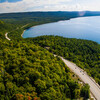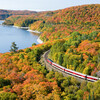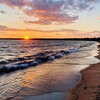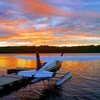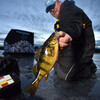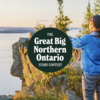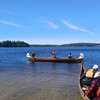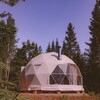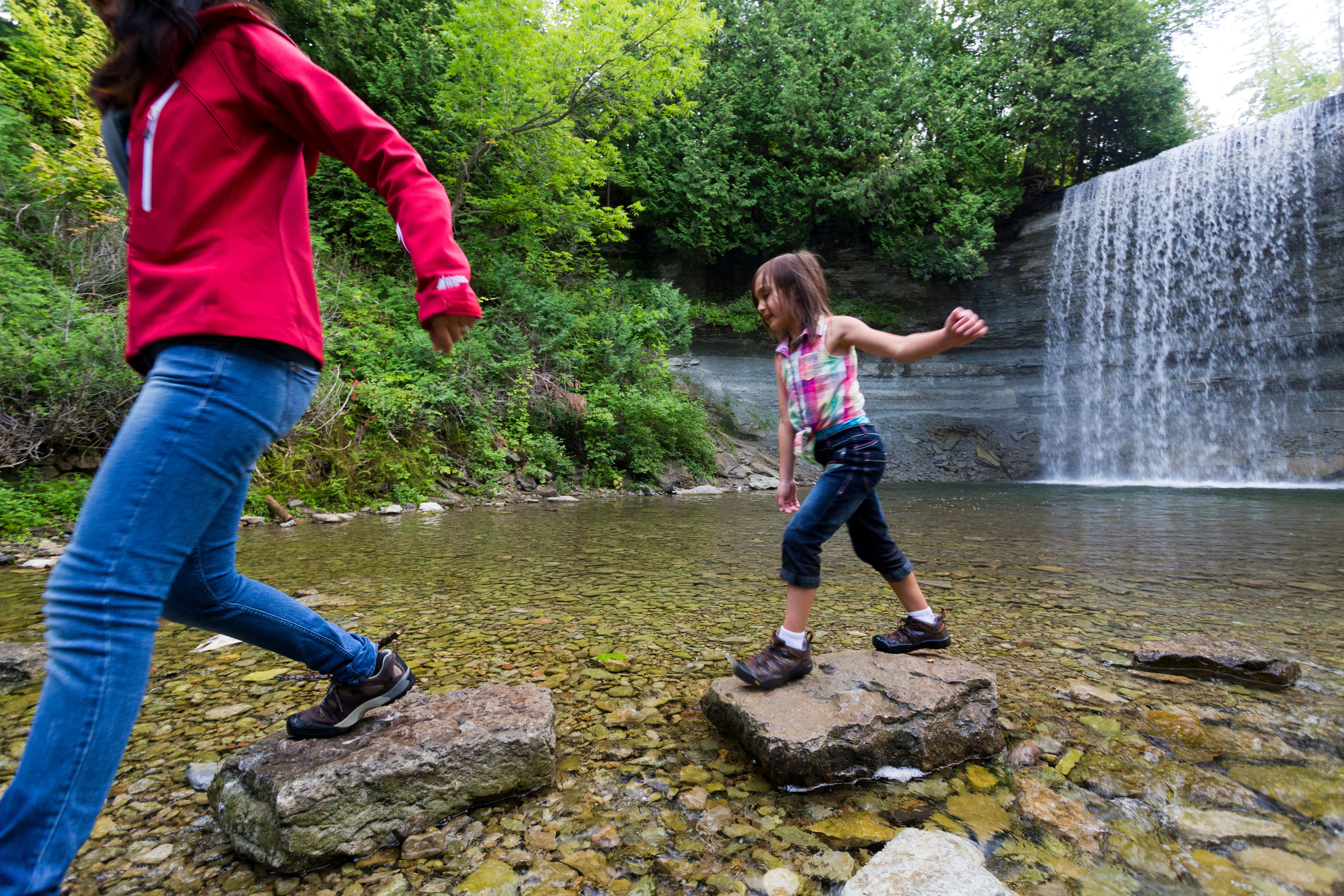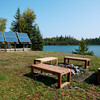
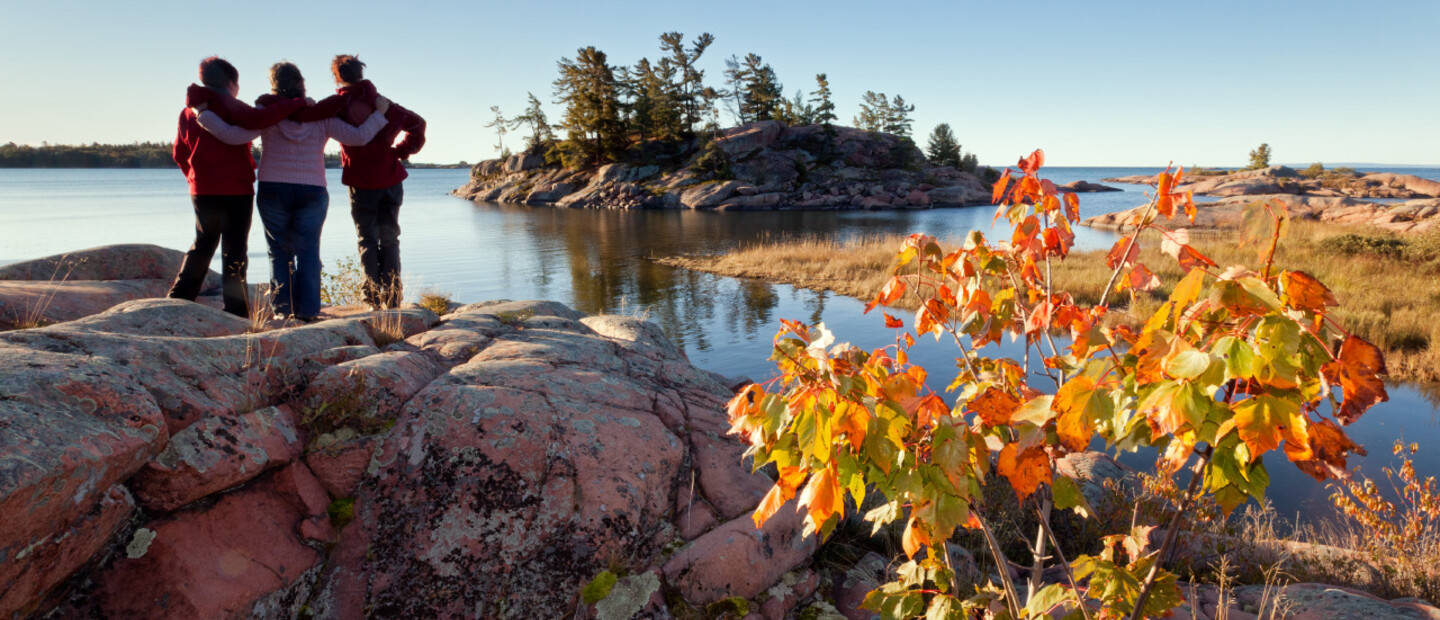
Northern Ontario’s Ultimate Guide to Sustainable Travel in the Off-Season
It’s a crisp October morning, meandering along a forested trail. Pausing, you take it all in. It’s oh so quiet; all but the wind’s gentle hush rustling through leaves. Rays of sunshine gleam through towering forest stands, and the fresh scent of pine lingers. Breathing in cool autumn air, it’s a moment to savour in a place where connection occurs organically, and sustainability goes beyond a slogan.
Enter Northern Ontario, the ideal destination for those seeking to travel with purpose. With vast boreal and Canadian Shield wilderness, this sprawling region invites travellers to explore and immerse themselves in nature, the environment, and its communities.
The Rise of Responsible and Conscious Travel
The shift towards travelling responsibly and intentionally is on the rise. According to the State of the Ontario Tourism Industry Report (2022), 71% of respondents said they wanted to travel more sustainably, and TravelPerk also reports that 69% of conscious travellers want their dollars to support local economies.
Why Northern Ontario is a Leader in Sustainable Tourism
Without a doubt, Northern Ontario is well-positioned to meet the demands of travellers seeking conscientious experiences. This has been demonstrated through ongoing regional commitments to support local businesses, environmental renewal and leverage natural assets. An example of success is Thrive Tours, an Indigenous-led company in Sault Ste. Marie, recently awarded the Leading the Way in Sustainability Award in 2025.
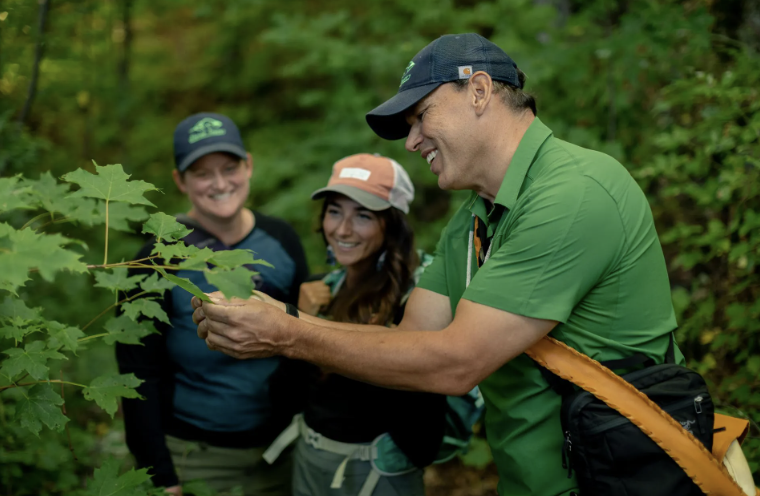
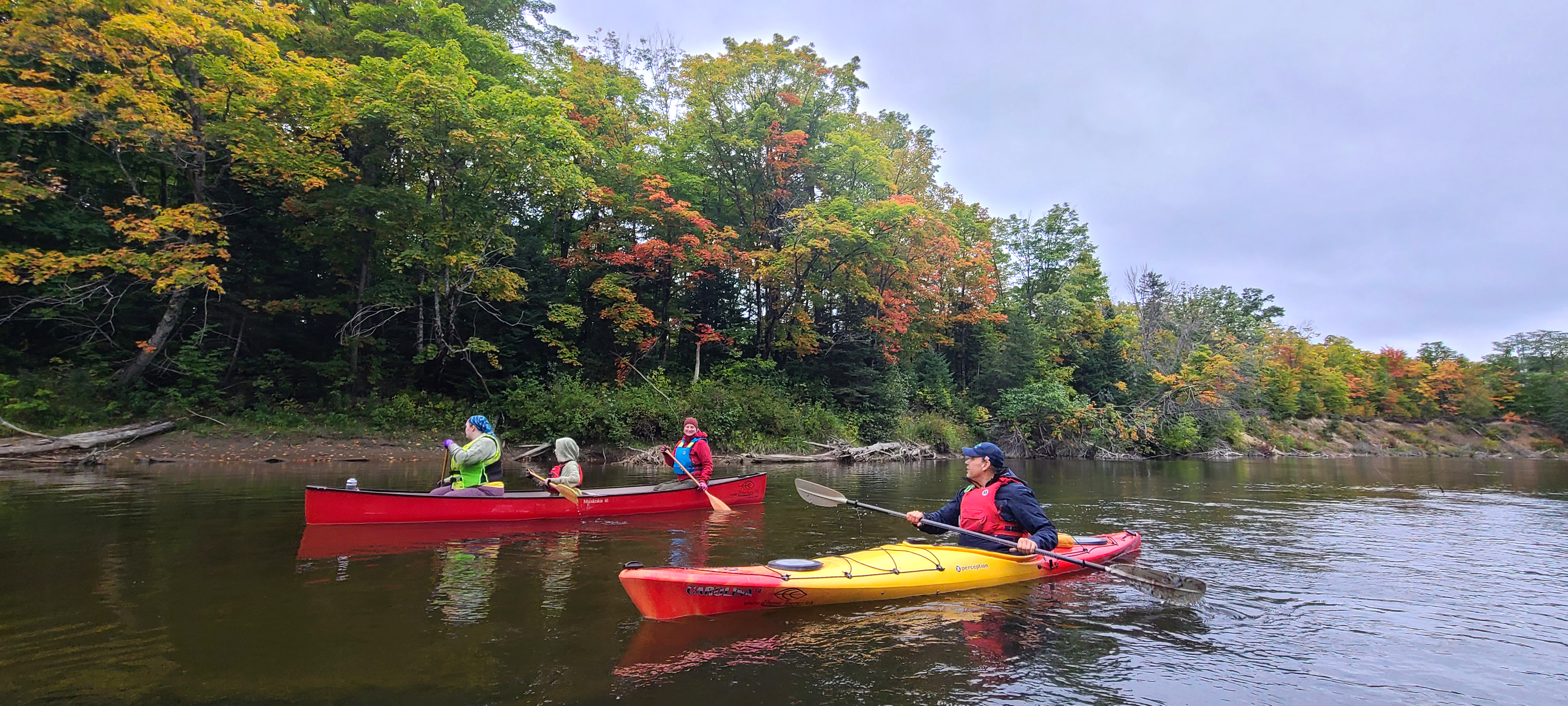
From Sustainable Tourism to Regenerative Travel
Sustainable tourism has laid the groundwork for something more encompassing, meaningful, and transformative: regenerative travel.
Regenerative travel goes beyond minimizing harm. It asks travellers to leave places better than they found them, while also choosing community-led options that benefit both travellers and the communities. In doing so, responsibility shifts from destinations alone to a shared commitment between travellers and the places they visit. Choosing low-impact activities like hiking or skiing, prioritizing learning and cultural exchange, and staying in off-grid eco-lodges can turn travellers' vacations into transformative experiences.
Off-season travel supports this approach. Slower travel during quieter times eases the strain on popular destinations while supporting tourism-dependent economies with visitation. It also allows travellers the time to create meaningful connections with community artisans, small businesses and guides.
Regenerative travel simply provides win-win solutions.
Fall to Spring: Best Shoulder Season Travel Options in Northern Ontario
Both fall and spring in Northern Ontario offer a slower, softer way to travel. These shoulder seasons mean fewer visitors on trails, more opportunities to connect with locals, and a chance to experience landscapes in transition. In fall, fiery leaves and crisp air create a dazzling backdrop, while in spring, rivers surge with snowmelt, wildflowers bloom, and wildlife increases activity. Choosing these quieter times not only deepens the traveller’s sense of discovery but also supports communities year-round by easing seasonal peaks and extending visitation.
With pristine wilderness throughout the north and communities eager to welcome sustainability-minded travellers, Northern Ontario invites travellers to experience gentler, restorative, and meaningful experiences.
Sustainable Travel Experiences in North Bay, Ontario
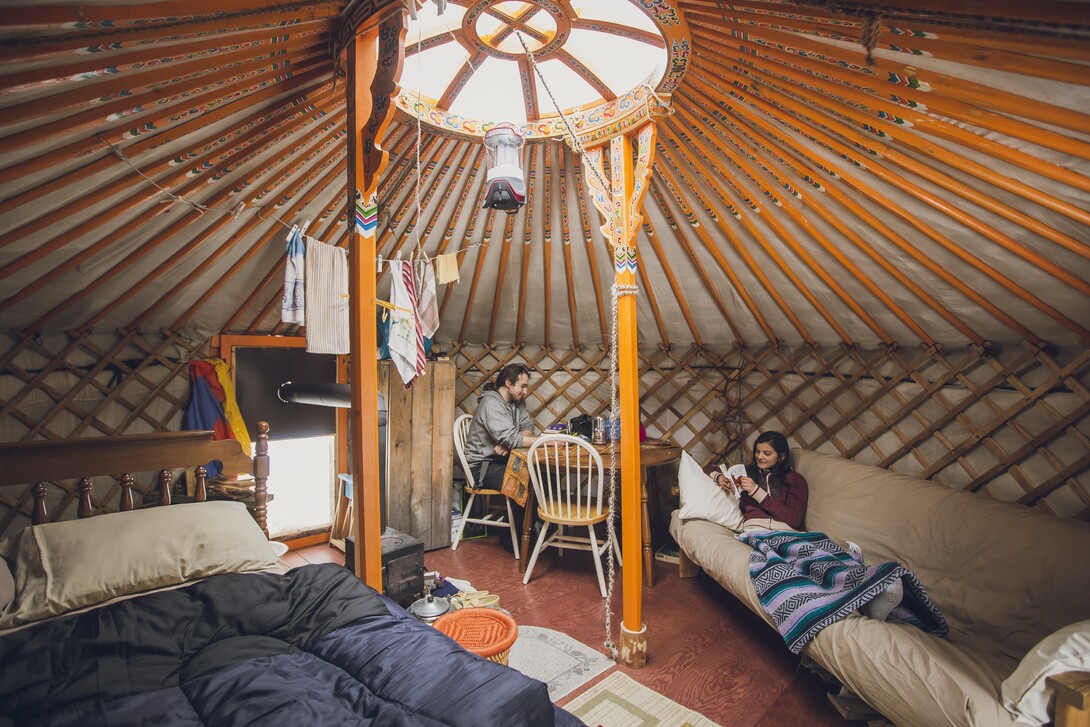
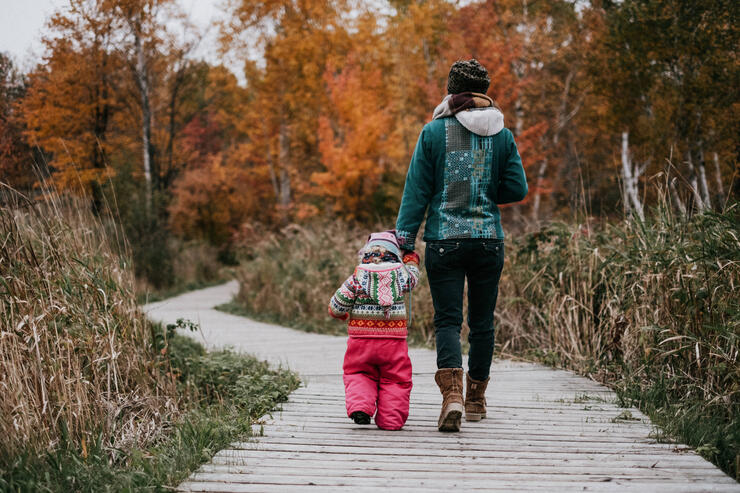
Surrounded by trails, parks and conservation areas, the waterfront city of North Bay, found between Trout Lake and Lake Nipissing, is a haven for outdoor enthusiasts.
Featuring 250 acres of forest and wetlands alive with migrating birdlife, Laurier Woods Conservation Area is a stunning region, especially in the fall when tamaracks turn golden. Nearby, hike, bike, ski, snowboard or snowshoe in the Laurentian Escarpment Conservation’s regenerated forest.
Duchesnay Falls, just minutes from downtown North Bay and bordering Nipissing First Nation land, also promises spectacular seasonal displays. In autumn, the beauty of the falls is complemented by fiery forest hardwoods, which transform into a magical frozen cascade, bordered by snow-filled pathways in winter.
Nature and wellness collide at off-grid Nature’s Harmony Ecolodge. Stay in a yurt, dome or cabin and then explore trails, plunge into icy water, or warm up in a wood-fired sauna. To learn about holistic regenerative farming and conservation of endangered heritage-breed animals, glamp at FoxFire Heritage Farm.
You can read more about sustainable travel options in North Bay here.
Eco-Friendly Adventures in Thunder Bay & Along Lake Superior
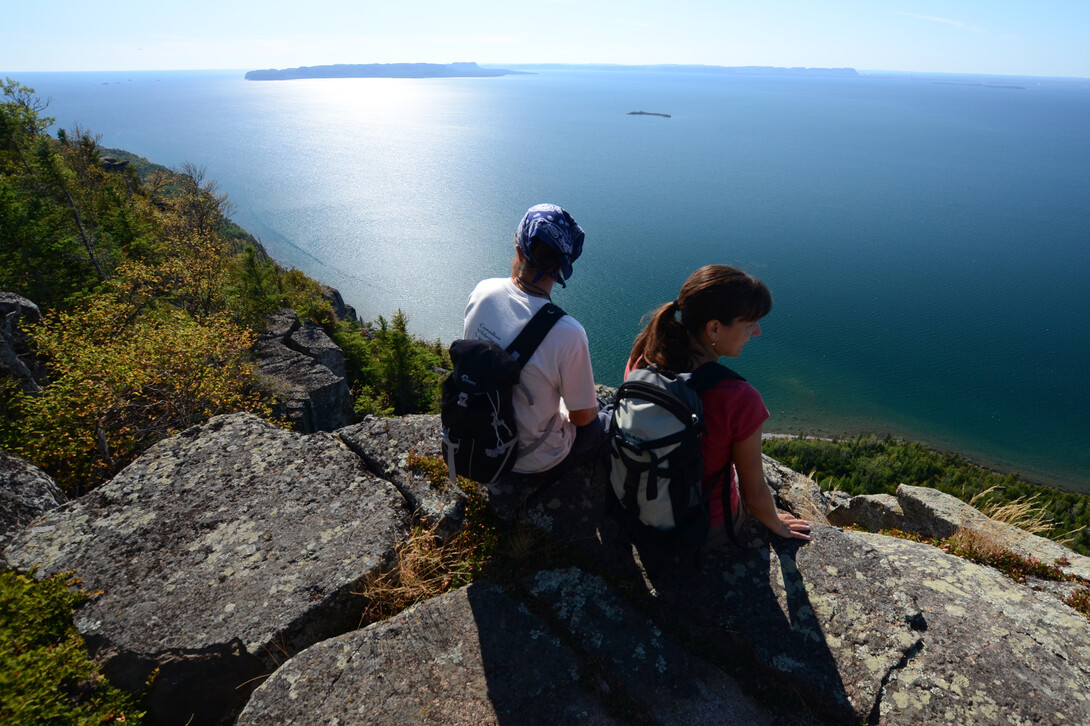
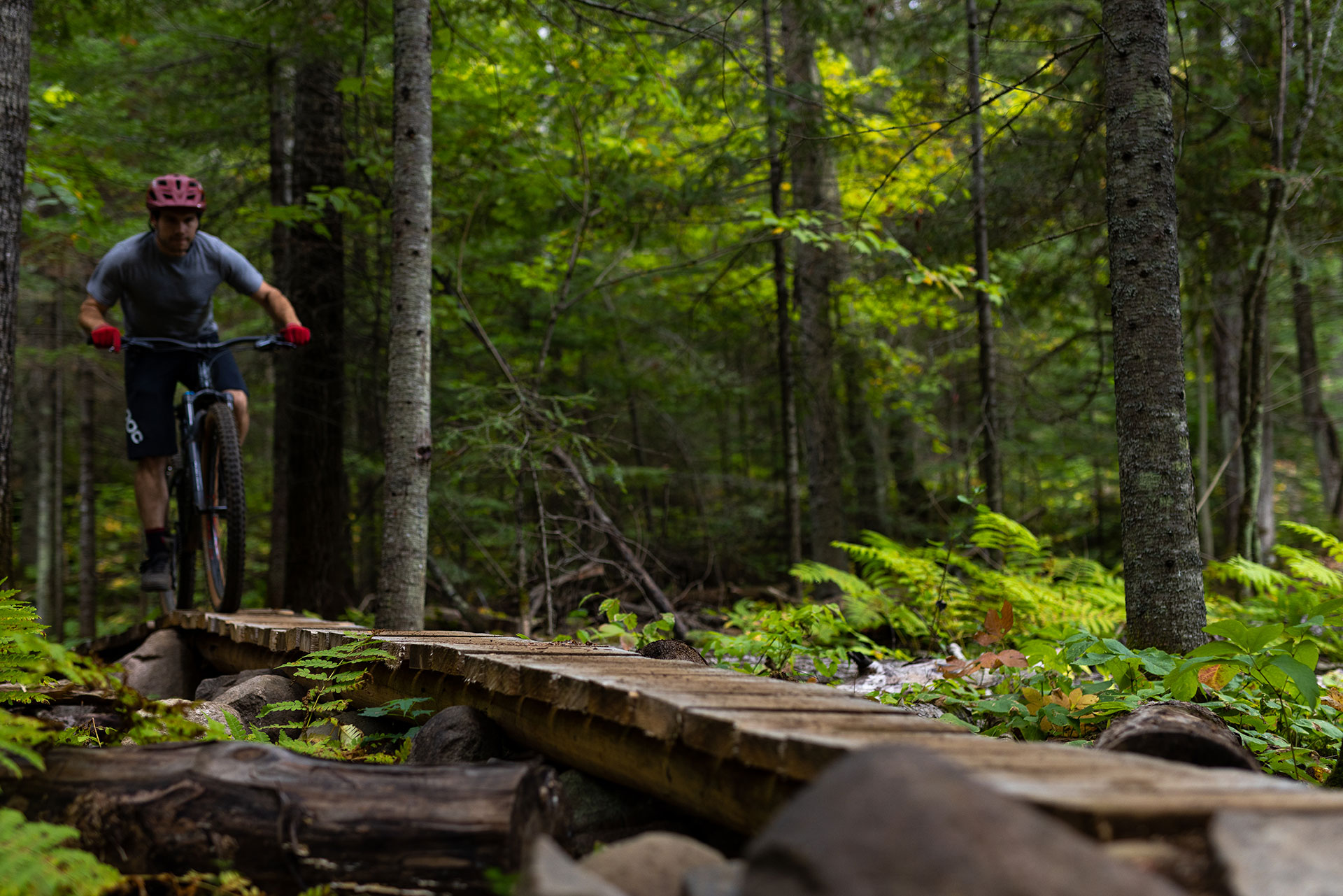
Set along Lake Superior, the world’s largest freshwater lake, and extending into Superior Country, Thunder Bay offers low-impact adventures amid wild landscapes. Head out on a hike or glide along groomed ski trails at Sleeping Giant Provincial Park, mountain bike single-track or Nordic double-track trails in Trowbridge Forest, or paddle Superior’s extensive shoreline.
In town, responsible feasting awaits. Stop by The Bannock Lady in Thunder Bay for traditional recipes and flavours, or Lot 66 for globally inspired, locally created, seasonal dishes. Sip on birch bark coffee at Baabaashi Gibichii or traditional wild rice and herbal teas at Tea Horse.
Choose a stylish yet sustainable stay at the Canvas Inn glamping retreat or Thunder Bay’s upcycled Courthouse Hotel, transformed into a boutique property on the waterfront.
Along Lake Superior’s wild coast, Pukaskwa National Park offers diverse hiking options, including the challenging yet rewarding 18 km trek to the White River Suspension Bridge, found 23 m above Chigamiwinigum Falls (open May–October). Keen campers can choose between frontcountry and backcountry camping, or a stay in a Parks Canada oTENTik.
Indigenous-Led Tourism and Outdoor Exploration in Sault Ste. Marie & Algoma Country
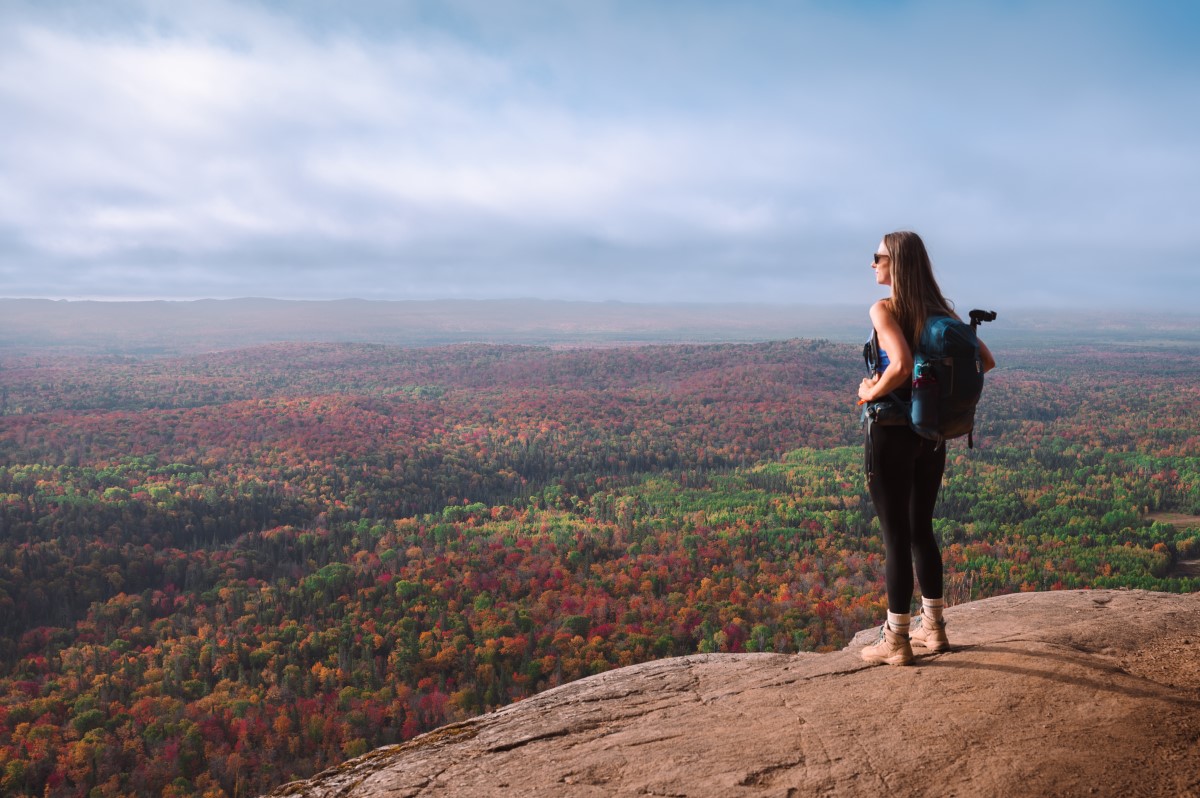
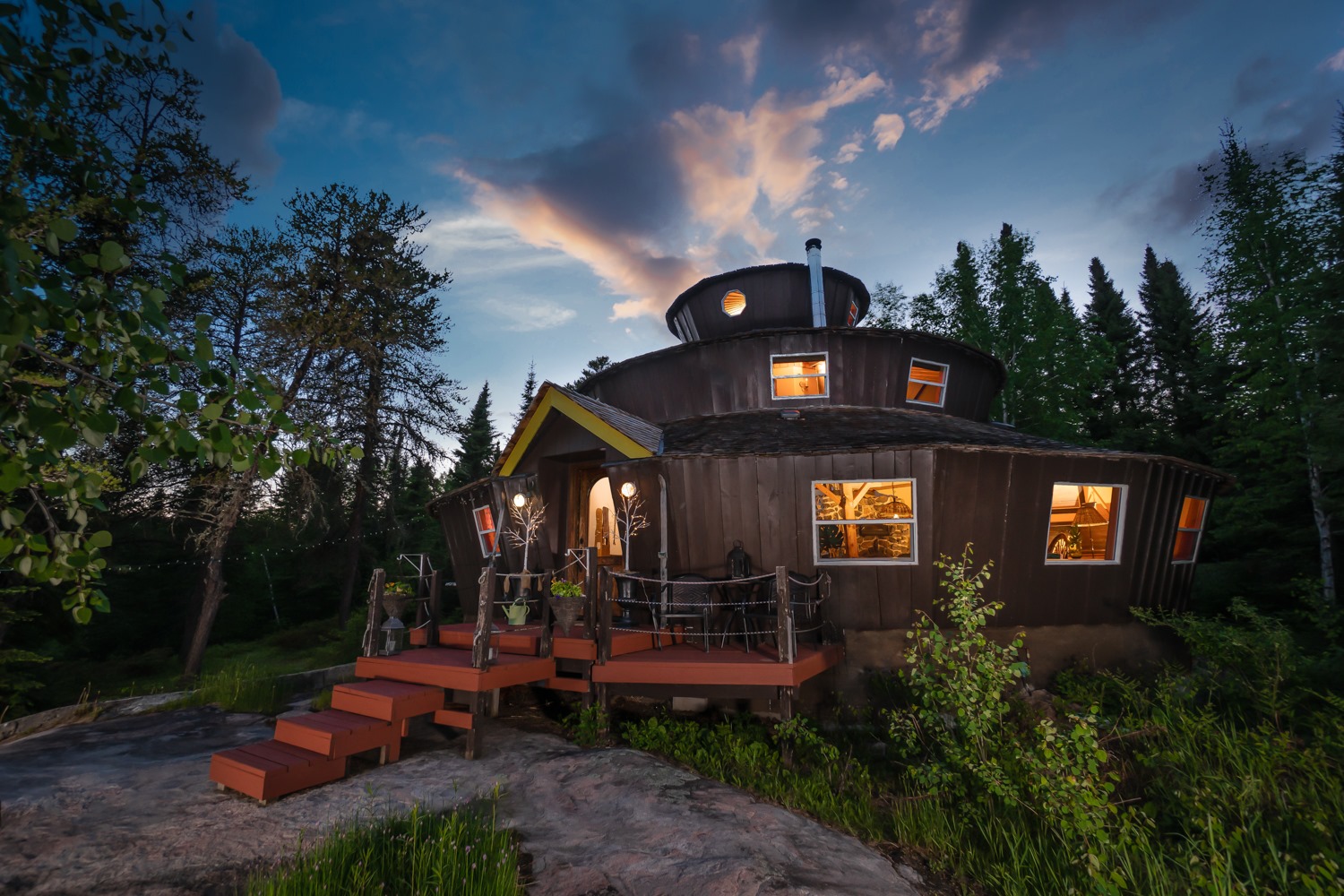
Brilliant landscapes await in Algoma Country, stretching from Sault Ste. Marie along Lake Superior’s eastern shore. Amble through forests of red maples in fall and in winter, explore Lake Superior’s icy coastline. Walk atop sandy beaches alongside Caribbean-like waters in Pancake Bay Provincial Park or climb to Robertson Cliffs to take in panoramic views across Bellevue Valley, the Goulais River, and Lake Superior.
Sault Ste. Marie has long been a gathering place of the Batchewana and Anishinabek peoples. Discover Indigenous heritage at the Sault Ste. Marie Canal National Historic Site or hit the 50 km of mountain biking and winter trails in Hiawatha Highlands. Add in a cultural immersion outing with Thrive Tours and learn from Indigenous guides how to build a relationship with the land.
Consider a rustic yet comfortable stay in a tipi or yurt with Minaki Yurt Adventures.
Regreening and Sustainable Travel in Sudbury & Northeastern Ontario
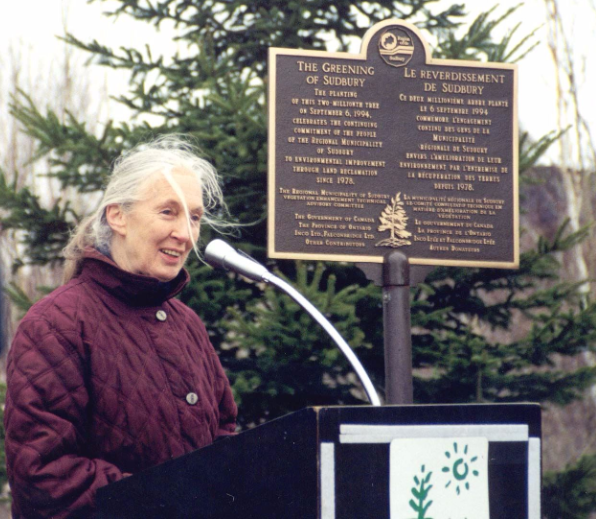
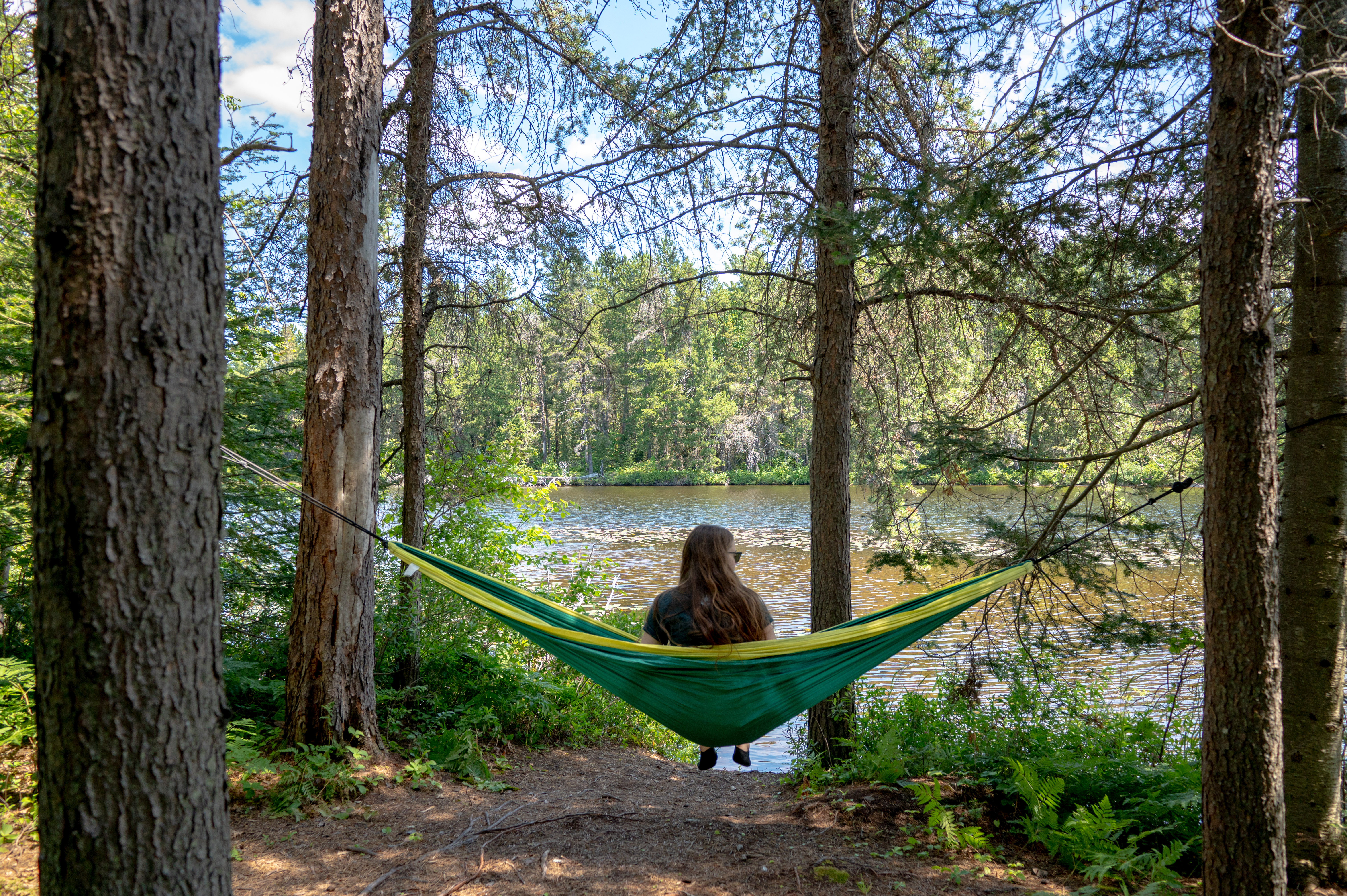
The transformation of Sudbury, Northeastern Ontario’s largest city, has been nothing short of remarkable. Once a mining town, the city began a regreening initiative in 1978 and has since planted millions of trees and become a model of inspiration for environmental renewal.
With 330 lakes and over 200 km of trails, urban and outdoor adventures are abundant. Explore 950 hectares of restored green space, including multi-use trails and wetlands at the Lake Laurentian Conservation Area. In winter, choose Kivi Park for snowshoeing, skiing, skating, or fat biking.
Consider a stay at Windy Lake Provincial Park, offering ski-in yurts and 8 km of camp-roads-turned-ski-trails, a sustainable choice for those who embrace cold-season adventure.
The north’s remoteness and lack of urban light make it a prime location for stargazing. Dark sky enthusiasts can enjoy unspoiled skies and experience the northern lights. Some top spots include Killarney Provincial Park, a designated Dark Sky Preserve found 90 km southwest of Sudbury or Manitoulin Eco-Park, which features a communal stargazing field, astronomy nights (and hikes), and camping, two hours southwest.
Wilderness, Canoe Culture & Dark Sky Adventures in Northwestern Ontario
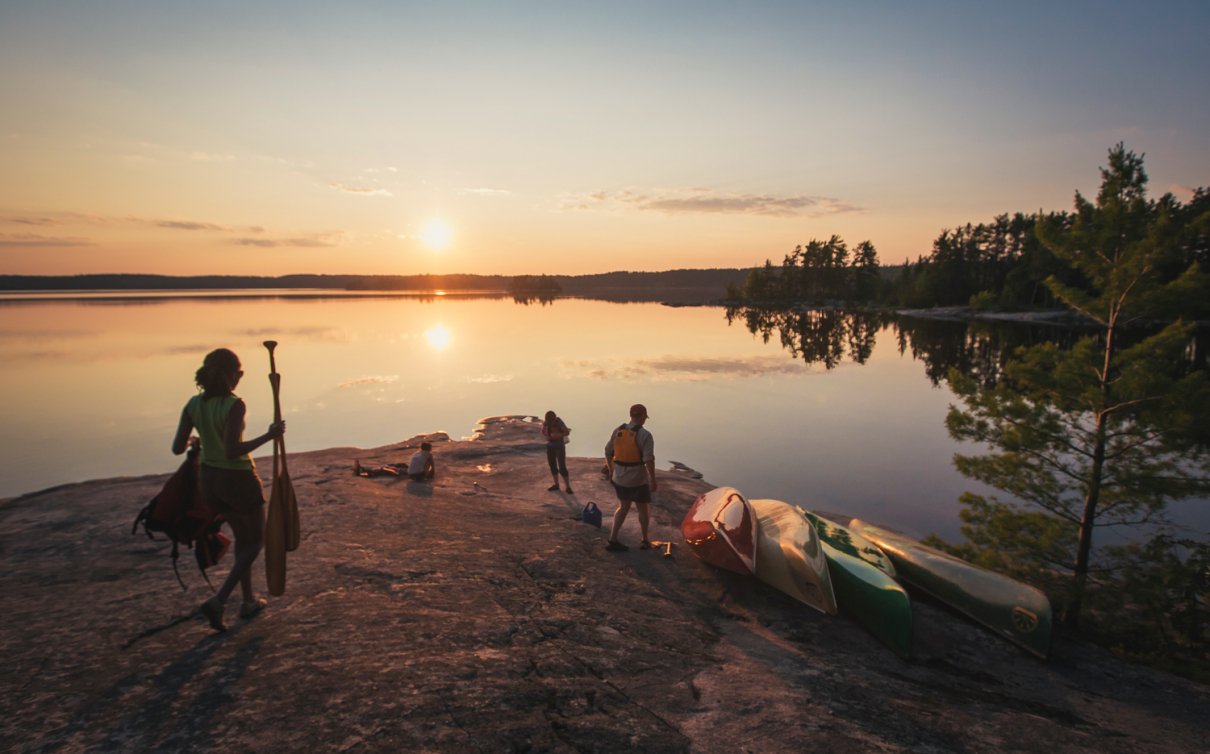
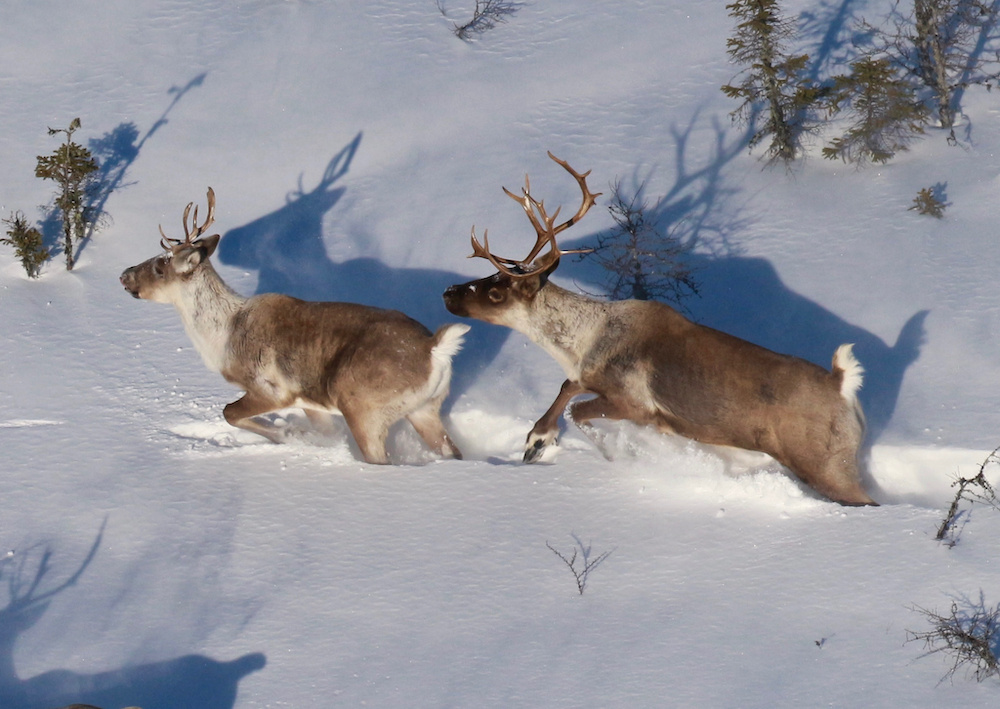
With over 70,000 interconnected lakes spanning the Canadian Shield and boreal ecosystems, Sunset Country (Northwestern Ontario) invites solace-filled canoeing and kayaking adventures. Wildlife is rich throughout the region, so keep your eyes peeled for moose, lynx, fox, bears, wolves and even threatened woodland caribou in Woodland Caribou Provincial Park. Northwestern Ontario’s expansive boreal forest and waterways make it an ideal location for adventure seekers who paddle, hike, and even stargaze.
Visit Quetico Provincial Park and choose a guided outing with Voyageur Wilderness to cruise along some of the more than two million acres of canoe country. Led by the voyageur heritage of the Métis Savoie family, travellers can learn about Quetico canoe culture while paddling, or around the campfire while staying in a rustic cabin on the secluded Voyageur Island Lodge, near Atikokan.
Quetico Provincial Park is famed for its rugged backcountry canoeing and sweeping wilderness, but just as impressively, for its dazzling night skies. As an officially designated International Dark Sky Park, Quetico offers a rare chance to gaze up at an untouched canopy of stars, free from light pollution. The Park also offers extensive backcountry and frontcountry camping as well as fishing, hiking and swimming.
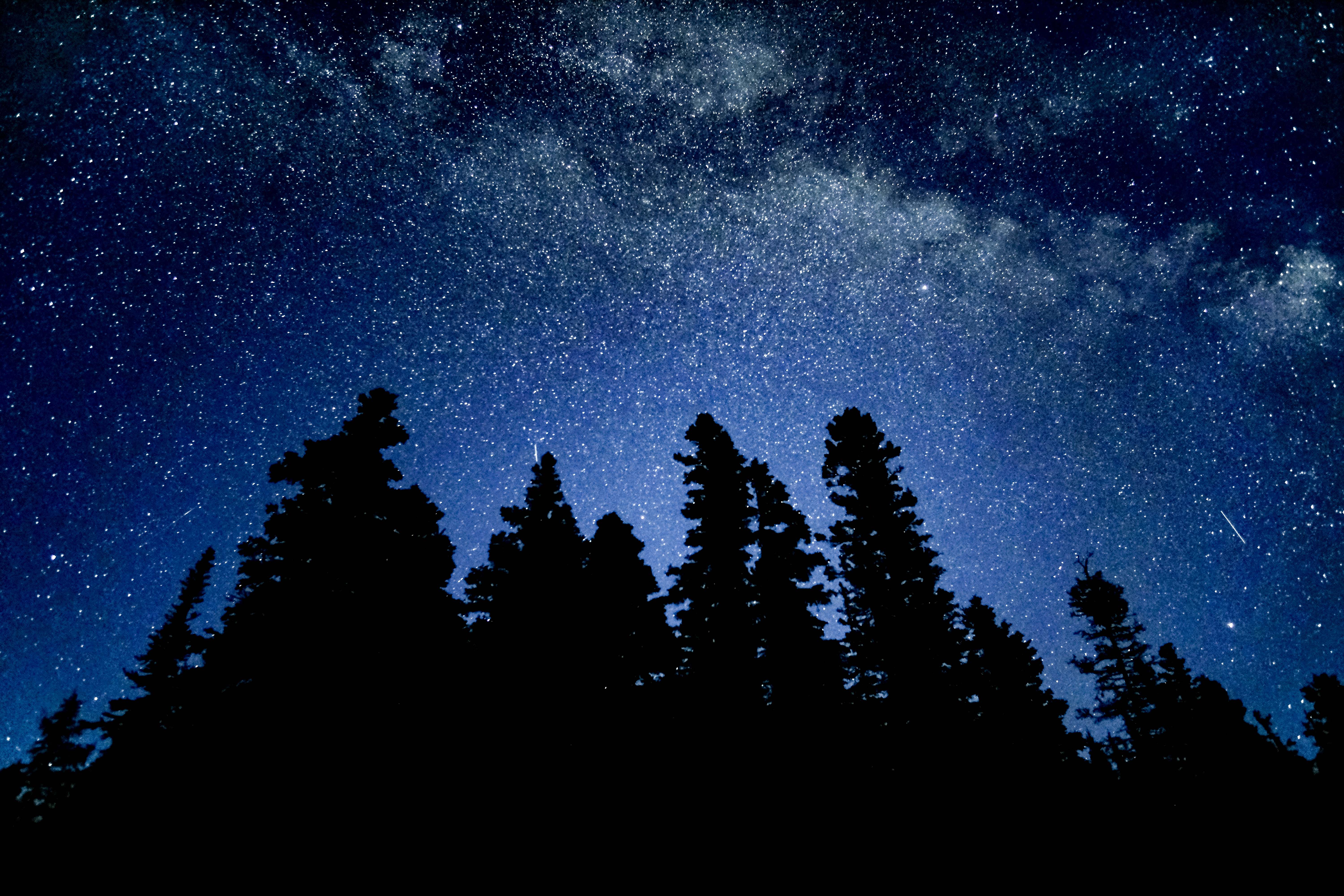
Practical Tips For Regenerative Travel in Northern Ontario: Simple Ways to Make a Big Impact
Want to travel sustainably? Follow these tips:
- Support local: food, artisans, business, and operators.
- Learn and exchange culture on a guided Indigenous-led tour.
- Tread lightly. Opt for low-impact adventures, such as hiking, kayaking, or snowshoeing.
- Follow the Leave No Trace principles.
- Spread tourism benefits by visiting during the quiet shoulder season.
- Choose an outdoorsy stay in a yurt or dome.
- Always respect wildlife and fragile ecosystems.
- Stay longer and connect more.
Why Sustainable and Regenerative Tourism Matters in Northern Ontario
Sustainable tourism and regenerative travel are no longer niche. The shift toward shared responsibility and reciprocity, for both travellers and the destinations they visit, is here to stay. And with Indigenous tourism leading as Canada’s fastest-growing sector, there’s never been more opportunities for cultural immersion, knowledge sharing and learning.
Travelling during the off-season may seem like a small choice, but it carries significant impacts, including supporting communities and preserving landscapes for future generations.
Whether it’s sipping birch bark tea, paddling Superior’s shoreline, hiking amidst golden tamaracks, learning from local or Indigenous guides, or sleeping under the stars, travels through Northern Ontario make it easy for mindful wanderers to experience deep connection and meaningful, authentic travel.
Recommended Articles
Northern Ontario’s Most Unique Stays

U-Pick Berries and Fruit in Northern Ontario

The Best Ice Cream in Northern Ontario: Where to Go This Summer

Fueling the Adventure: A Sweet Butter Tart Road Trip Through Northern Ontario
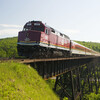
Top 10 Things To Do in Northern Ontario
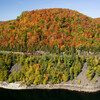
See the Leaves Change: Fall Colour Report Ontario 2025
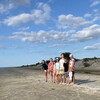
7 Amazing Northern Ontario Islands You Must Visit

The Agawa Rock Pictographs

6 Dark Sky Preserves in Ontario

Best Vinyl Record Stores Ontario (That aren't in the GTA)

The World's Smallest Record Store Is Not Where You'd Expect
The Northern Ontario Beer Trail: 8 Essential Stops For Beer Lovers

12 Times TikTok Was So Northern Ontario

7 Species Worth Fishing for in Ontario

10 Sights To See By Motorcycle In Northern Ontario

A Road Trip to Red Lake

The Eagle

Pride Events in Northern Ontario 2025
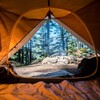
How to Book a Campsite in Ontario

9 Films About Northern Ontario You Have To Watch

7 Stompin’ Tom Connors Songs About Northern Ontario
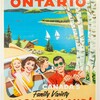
17 Amazing (and Random) Vintage Ontario Tourism Ads That Will Definitely Make You Want to Travel This Summer
